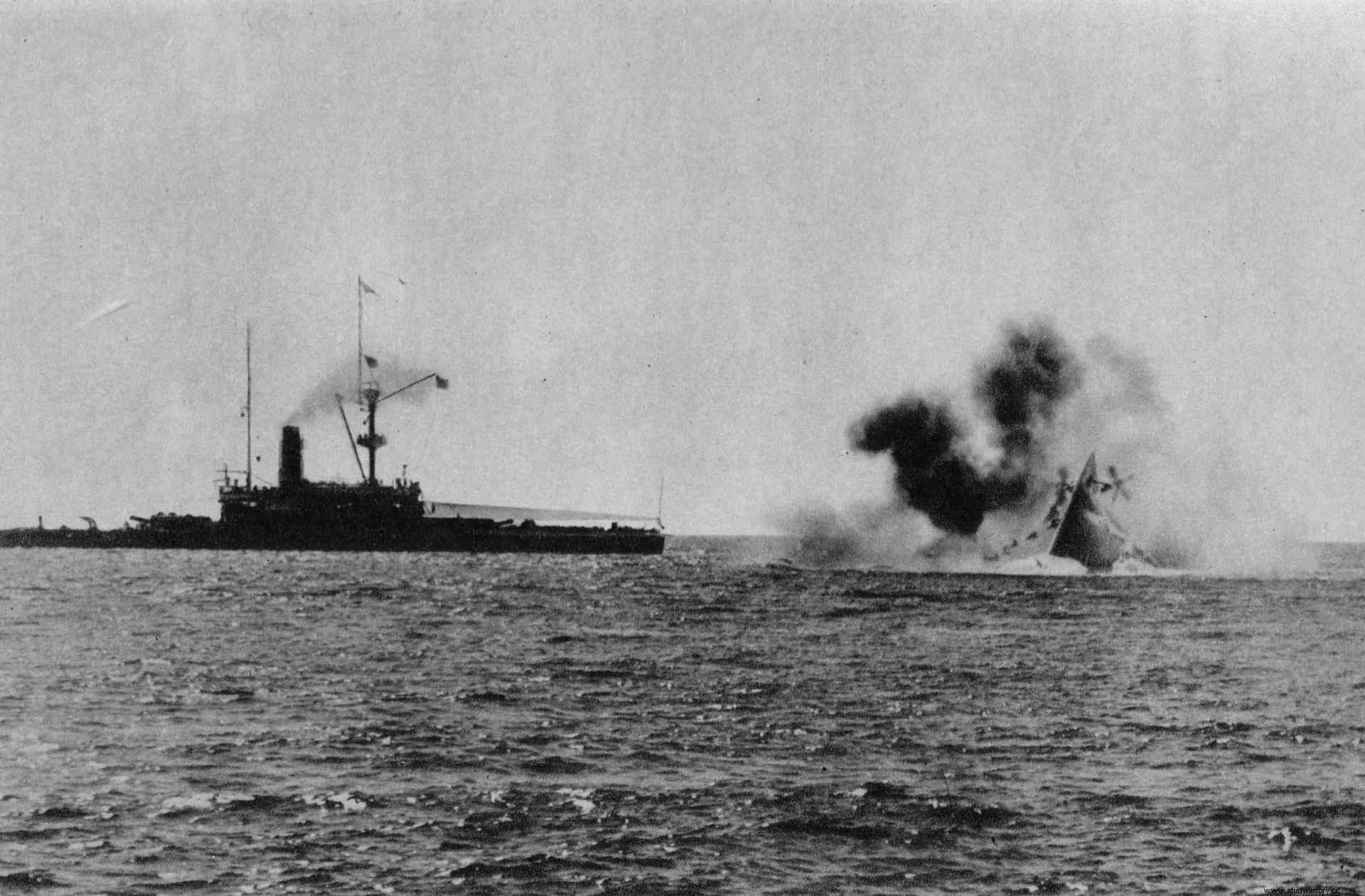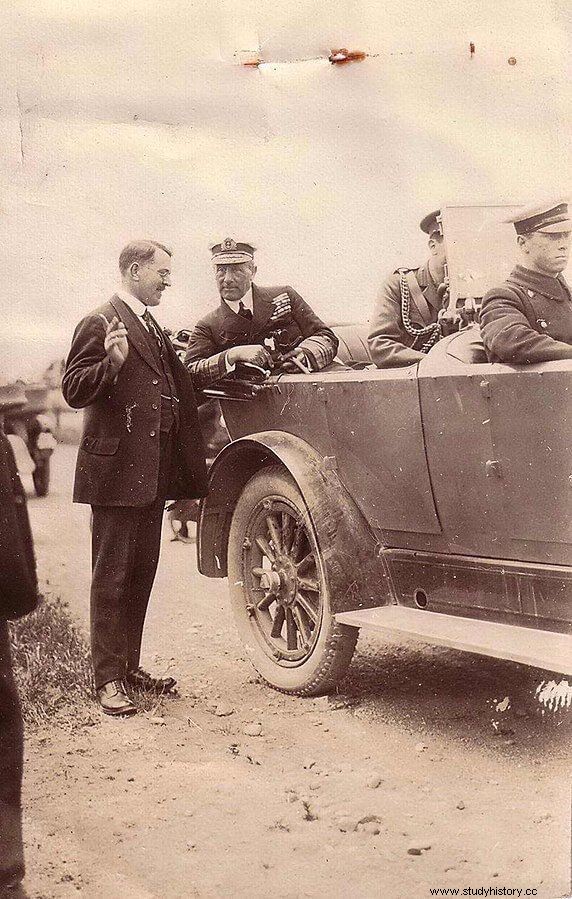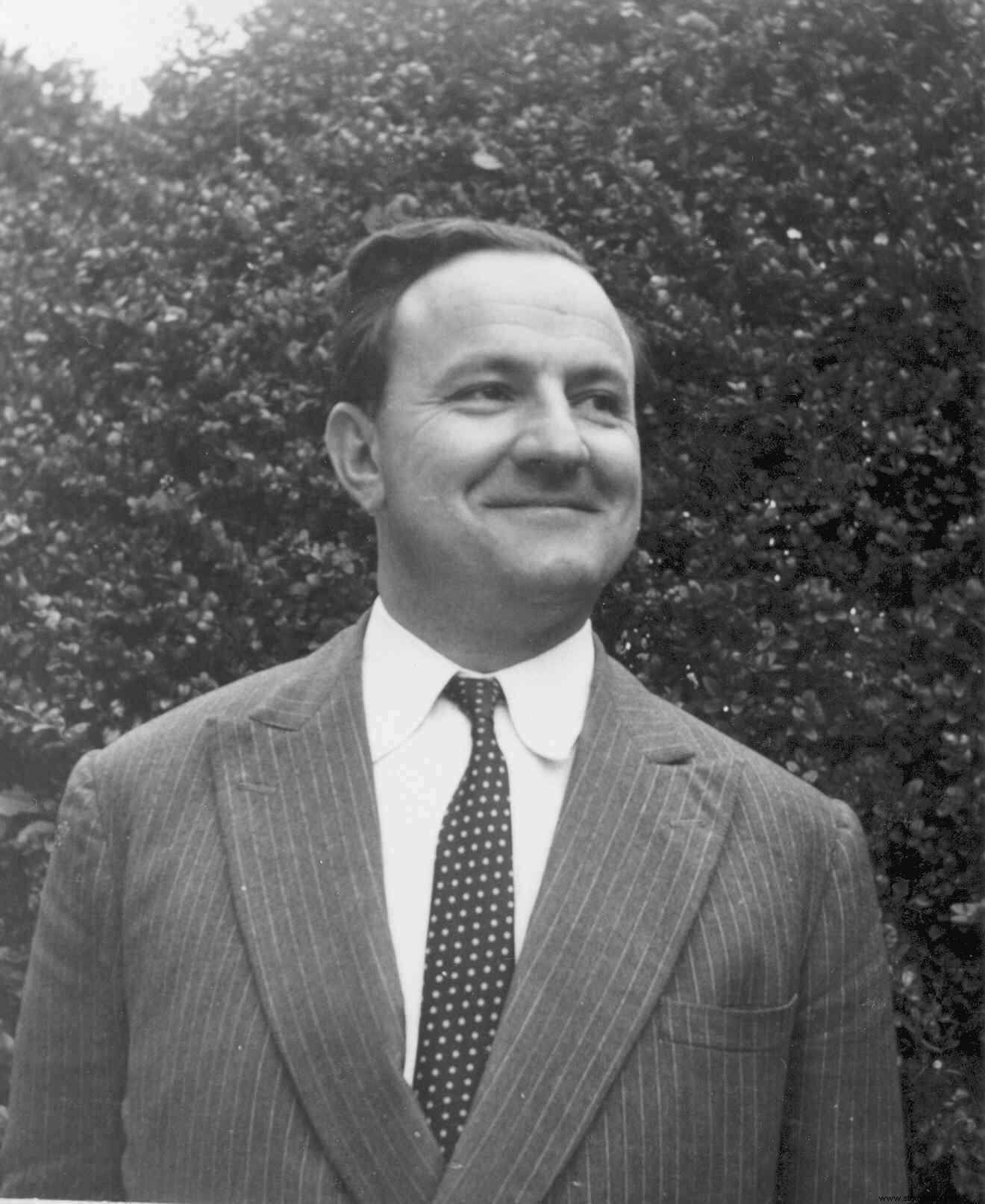
When, one year after the Battle of Jutland , Lloyd George referred to the stupid Admiralty chiefs who opposed the convoy, which he and others he had convinced would be the "silver bullet" of anti-submarine warfare, unjustifiably included John Jellicoe on the list of attacked, when in fact he had concluded that the fight against submarines was a more complex challenge than the British prime minister thought. Jellicoe's failure to win a resounding victory at Jutland and his removal from office by Lloyd George in the last days of 1917 obscured the achievements of what would be described by Corelli Barnett as "the seaman with the jagged cutlass"; however, today his contribution to the successful development of naval warfare has finally been recognized.
John Rushwort Jellicoe (1859-1935) was born at a time when the naval traditions of his country, Great Britain, based on centuries of unchallenged supremacy, were undergoing great technological and social. He had the sea in his blood. His father had been a captain of her own ship at the age of twenty-one, and another of his ancestors, an admiral, had fought alongside Nelson at Trafalgar. From an early age, J.R.J. [as the author likes to call him] knew he was destined for greatness, even though he almost wasn't. He began his naval training at the age of thirteen, with excellent results, placing first in the four courses he attended on the training ship HMS Britannia, from which he graduated with a certificate of excellence in 1874, and was promoted to midshipman.
A singular race

Like other admirals of the era dreadnought , J.R.J. was formed during the age of sail. His first sea assignment had been aboard a 131-gun first-class ship called HMS Duke of Wellington , the same character that would inspire the name of his flagship, HMS Iron Duke, when he took command of the Grand Fleet. Later, during his service aboard HMS Agincourt he decided that his specialty would be artillery. In 1884 he was appointed to the faculty of HMS Excellent, the artillery school at Whale Island [near Portsmouth, although it has the name of a ship, it is an installation on land and not a ship], where under the attentive patronage of Jacky Fisher – installation captain and later admiral whose reforms were to lead to the creation of today's Royal Navy – and in his capacity as artillery experimentation officer, he helped develop two new pieces that were to revolutionize naval warfare:the 4.7 in (120 mm) standard and QF for quick firing ] of 6 inches (152 mm). His next and obvious destination was aboard HMS Colossus, the most modern ship in service, armed with breech loading parts (in English BL for breech loading ) of 12 inches (305 mm). In 1889, when Fisher became director of the naval artillery, he took Jellicoe on as assistant.
J.R.J.'s career accelerated dramatically. In 1891, at the age of thirty-one, he rose to the rank of frigate captain and, on his return afloat, was second-in-command of HMS Sans Pareil—then commanded by Captain "Tug" Wilson, who later rose to the rank of admiral. –, before moving on, a little over a year later, to HMS Victoria, flagship of Admiral Sir George Tryon, Commander-in-Chief of the Mediterranean Fleet, which would end up colliding with HMS Camperdown because of orders issued by Tryon himself. Luckily, at that time Jellicoe, who was in his cabin with a fever, was able to escape [HMS Victoria sank, killing 358 men, including Tryon himself].

He did not see action again until Vice Admiral Sir Edward Seymour asked him to join the Chinese force as captain of HMS Centurion, which was his flagship, a position which he enthusiastically accepted as his request to go to the Sudan had been refused. It was there that he made the most important contacts. Among the Germans he met Prince Heinrich, brother of the Kaiser, Captain Henning von Holtzendorff (one of the key men in submarine operations in 1917) and Guido von Usedon (later in charge of German shipyards); and among the Americans, William S. Sims, with whom he would work closely to bring US naval resources into the Royal Navy's battle against the submarine threat. Jellicoe was on the verge of not returning from China, as he was almost mortally wounded while leading an Anglo-German contingent in the fight against the Boxers. It is ironic that one of those who helped evacuate him was David Beatty , who was to be the head of his battlecruiser force in Jutland.
His recovery and subsequent appointment as assistant to Admiral Sir William May, third Lord of the Sea and Controller of the Admiralty, led our protagonist to meet his future wife, as well as to gain in-depth knowledge of shipbuilding. It was while he was visiting the Glasgow shipyards, and thanks to the fact that he sometimes stayed with the family of Sir Charles Cayzer, head of the shipping company, that he fell in love with one of his daughters, Gwendoline. They were married in July 1902 and moved into an apartment above Harrods. At that time he was responsible for the design, construction and repair of Royal Navy ships, an experience that led him, in 1904, to join the design team for HMS Dreadnought , where he was in charge of the main armament. In 1907, as head of the ordnance committee, he became aware of the shortcomings of British ammunition and, before leaving the naval ordnance office, he petitioned the ordnance board to design new armor-piercing shells, for what he felt would be a long distance battle. Unfortunately, he was transferred before he got anything, which would have great importance in Jutland.
Thanks to Fisher's sponsorship, which prepared him for high command, he was promoted to Rear Admiral and later asked to take up a command position in the Atlantic Fleet. Some time later and for the first time in his career, he hesitated before accepting a new position, it was that of third Sea Lord and controller of the Admiralty, because he knew that he would end up at the center of a great political controversy:What should the nation, build dreadnoughts or a welfare state? Concerned about the speed of German shipbuilding and the capacity of its ships, he tried to persuade Churchill, on several occasions, to pay more attention to the displacement of ships than to their artillery, since the distribution of weight in ships The British leaned proportionally more towards mounting larger caliber parts (and heavier turrets) than towards armor and further subdivision of the hull with watertight bulkheads.
In late 1912 he was promoted to take command of the Home Fleet's 2nd Fighter Squadron, ensigned aboard HMS Hercules, before becoming second in command command of the man whom he would replace in 1914, a person he deeply respected and therefore had little desire to fire:Sir George Callaghan . In the end, against his will and at Churchill's insistence, on August 4, 1914, Jellicoe became Commander-in-Chief of the Grand Fleet. Despite this, Callaghan would remain a friend of the family, and would even play a relevant role in the christening of Jellicoe's son, father of the author of this article, in 1918.
Jellicoe and the Battle of Jutland

For decades, the quiet outcome of this battle divided the Royal Navy in an ugly dialectical struggle between two rival factions, centered on Admirals Jellicoe and Beatty (so different that it would be difficult to find a more extreme case). The former was attacked for his caution and overcontrol; the second praised for its aggressiveness. Hundreds of authors, including this writer, have written rivers of ink about Jutland, and the truth is that, although Jellicoe made mistakes, he also managed to fulfill his fundamental objective, to maintain the status quo , the continuation of British maritime rule.
Most of the criticism that fell on this admiral after the battle focused on his mode of command, embodied in his Grand Fleet Battle Orders (GFBO, "Grand Fleet Combat Orders"), text of orders considered "voluminous", excessively detailed and that curtailed all initiative. Although Jellicoe made it clear at the beginning of his tenure that once the combat began, he had the individual initiative of each commander since reaction time was always going to be short and the fog of war would make it dangerous to rely too much on a centralized command , did not stick to this philosophy on the day of battle. After succeeding him, Beatty kept the GFBO in force almost in its entirety until February 1918, although he did issue, somewhat theatrically, a three-page summary called the Grand Fleet Battle Instructions (GFBI). ) that mimicked Nelson's famous fighting instructions and had always had to be interpreted in conjunction with, and not in substitution for, Jellicoe's GFBOs. Only on the aforementioned date did he issue a text of his own orders, which was essentially the same as the previous one, although an additional chapter on aviation was added and its length was reduced from seventy to fifty pages.
Jellicoe's decision to turn away from the threat of torpedoes late in the afternoon of May 31 was another criticism, for lacking offensive spirit and leading to the loss contact with the enemy. However, it is necessary to consider that, with the day about to end, it was the only logical decision if the objective was to safeguard the fleet. Where it is possible, however, to criticize the admiral, was for the problems of intelligence information management:he did not use his cruisers (or destroyers) aggressively to maintain contact with the enemy, nor did he instill in his subordinates the importance of sharing what they knew. Finally, he too can be criticized - like Beatty - for his excessive loyalty to officers who did not perform well enough (such as Admiral Jerram, or later Reginald Bacon), or for his apparent inability to delegate. .

On the positive side, it must be said that his His comments on German shipbuilding turned out to be correct, as did his comments on the enemy's tactical efficiency, the unseen submarine threat, and his criticism of British ammunition and the poor performance of battlecruiser artillery. When, on November 28, 1916, he relinquished command of the Grand Fleet, he had the unquestioning respect and adoration of the entire fleet.
Anti-submarine warfare
At Asquith's request, Jellicoe was appointed to command the Admiralty as First Sea Lord, a position in which his challenge was to find a solution against the growing threat of submarines . He immediately created the Anti-Submarine Division, which would focus British maritime resources on this mission, for which he brought in some of the officers who had worked most closely with him in the Grand Fleet:Alexander Duff, William Fisher (who would assume the role of Duff), Frederick Dreyer (his artillery officer), and Lionel Halsey (who became fourth Sea Lord).
When Germany declared the second campaign of unrestricted submarine warfare in February 1917, Allied losses in merchant shipping rose immediately to 860,000 tons in the last two weeks of April. However, this month was also the turning point. On May 6, the Americans declared war on Germany and began to contribute to the war with destroyers, which arrived at Queenstown (Blackpool, England) on May 4. The rapid integration of US naval assets was greatly accelerated by Jellicoe's friendship with Sims, so that by July there were 35 US Navy destroyers in allied waters.

The convoy it was an incredibly important asset in defeating submarines, but not the "ultimate weapon" many historians would have us believe. Crossing the Atlantic, in convoys, successfully would have been very difficult without those additional destroyers. Anti-submarine warfare requires a complex collection of solutions to restrict submarine routes, detect and destroy them. The technologies that today we associate with this type of warfare – including ASDIC (SONAR), depth charges or torpedoes – either did not exist or were in the early stages of development; the same, on the other hand, as the famous herd tactics that the Germans would implement twenty years later (see Awake Ferro Contemporary No. 12:The Battle of the Atlantic ).
What Jellicoe did was to vigorously push a whole series of options. As far as intelligence is concerned, although fundamental his influence was slight, but under Jellicoe's direction the Room 40 [headquarters of the Admiralty cryptanalysis service during the First World War] he began to concentrate more and more on accumulating metadata instead of focusing on deciphering communications, on working with information patterns instead of just knowing what the messages said . Aerial reconnaissance also served as support in this field, but the presence of aircraft could be a deterrent or, on the contrary, guide enemy submarines towards possible targets. The barriers (both in the English Channel and, although less so, the later one in the North) were not, in themselves, weapons of destruction, but rather facilitated the action of other means, such as mines, or limited the options of the submarines by forcing them to take longer to access the areas where the targets were, and making the journey more dangerous. The same thing happened with the large fleets of civilian fishing boats and fast patrol boats, which forced submarines to spend more time submerged. It is important to note that the effectiveness of some weapons declined over time, and some even argue that their existence adversely affected enemy tactics for the British. For example, the early successes of the Q ships – merchant ships equipped with concealed weapons – caused the Germans to turn to unrestricted attack tactics.
Naval strategy during World War I was built for long-term contention, to slowly but inexorably strangle the German war economy and the will to fight of the population. Consequently, its successful execution required patience, maintaining one's naval dominance, and avoiding risks. As Sir David Beatty would later comment on the decision to keep the Grand Fleet sheltered in the northern reaches of the North Sea:“When you are winning, risk nothing”. Jellicoe's role may not have been, from the point of view of the British public, Nelsonian in character, but it proved just as effective.
Nicholas Jellicoe , grandson of Admiral Sir John Jellicoe, is the author of Jutland. The Unfinished Battle , creator of the website www.jutland1916.com and the video The Battle of Jutland Animation, a stupendous short-form recreation of the Battle of Jutland. Currently, he is writing a new book:The last Days of the High Seas Fleet, about the self-sinking of the German fleet at Scapa Flow in 1919.
